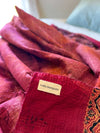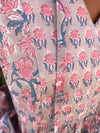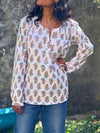
With the arrival of sunny days, shop windows are adorned with vibrant patterns, shimmering colors, fabrics that seem to speak another language - that of travel, warmth, and elsewhere: for several years, patterns inspired by ikat weaving, bandhani dyeing or even blockprinting have appeared in the collections of many international brands.
Ikat, blockprint, bandhani: these terms aren't always mentioned on labels, but their shapes populate lightweight dresses, loose-fitting shirts, and bohemian scarves. We wear them because they're beautiful, evocative, and vibrant. And that's perfectly fine.
But did you know that behind these prints lie treasures of traditional craftsmanship?
Ikat, Bandhani, Blockprint: much more than just patterns!
Ikat is a complex weaving technique in which threads are dyed before being woven, creating vibrant, blurred patterns. This skill, passed down from generation to generation, requires weeks of work.
Bandhani, a painstaking tie-dyeing technique, produces delicate polka-dotted fabrics, often used in traditional turbans or saris, particularly in Gujarat and Rajasthan.
Block printing is a manual printing method using engraved wooden stamps dipped in natural dyes. Each color and pattern requires a different stamp and extreme precision. This technique is emblematic of Rajasthan and Gujarat and requires hours of craftsmanship for each meter of fabric.
Wear with awareness, without sacrificing beauty
This isn't about pointing fingers or creating guilt around the clothes we wear. After all, it's legitimate to be drawn to these characterful prints. But we can look a little further than the pattern and ask ourselves the question of its origin, its manufacture, and its reinterpretation.
Because today these unique skills are disappearing: copied by the global textile industry, which reproduces them en masse using industrial printers, these patterns become "trendy" but lose their connection with the history, peoples, and techniques that gave birth to them. Craftsmen cannot compete with the prices of industrial copies. Real pieces, made by hand, "become" too expensive: prices are compared and it is the wallet that chooses, without any human and environmental considerations. If these professions no longer allow people to live, the younger generations no longer take them up. Knowledge is lost, and with it, an inestimable cultural wealth.
What can be done
We can simply ask: Is it a fabric mechanically printed like ikat? Is it a blockprint -inspired dress, but industrially produced? This doesn't detract from its aesthetic, but knowing it gives us power: the power to choose, to support, perhaps one day, artisans, a designer who supports them. Or simply to wear these pieces with a little more awareness—and a lot of respect.
We can also share these techniques by talking about them with those around us and promote this know-how by buying, when possible, from brands or artisans who perpetuate the tradition.
Far from any moralizing discourse, this is a gentle call to curiosity. To this capacity that we have, as consumers, to restore value to the gesture, to the slowness, to the imperfection, to the work of these women and men. To celebrate not only the "style," but also the soul of these textiles.




0 comments